
Recommended Reading List 2
Historical Overviews - These books are the big-picture historical overviews of the Pacific War. In the end, it is the historians that make sense of what has come before.
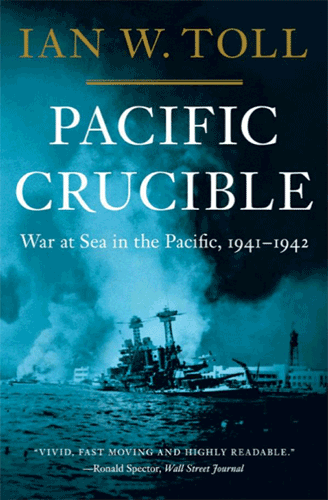
Pacific Crucible: War at Sea in the Pacific, 1941-1942
Ian W. Toll
The planning, the strategy, the sacrifices and heroics―on both sides―illuminated the greatest naval war in history. Pacific Crucible is the first volume of Ian W. Toll's Pacific war trilogy.
On the first Sunday in December 1941, an armada of Japanese warplanes appeared suddenly over Pearl Harbor, Hawaii, and devastated the U.S. Pacific Fleet. Six months later, in a sea fight north of the tiny atoll of Midway, four Japanese aircraft carriers were sent into the abyss. Pacific Crucible tells the epic tale of these first searing months of the Pacific war, when the U.S. Navy shook off the worst defeat in American military history and seized the strategic initiative.
Ian W. Toll's dramatic narrative encompasses both the high command and the "sailor's-eye" view from the lower deck. Relying predominantly on eyewitness accounts and primary sources, Pacific Crucible also spotlights recent scholarship that has revised our understanding of the conflict, including the Japanese decision to provoke a war that few in the country's highest circles thought they could win. The result is a page-turning history that does justice to the breadth and depth of a tremendous subject. 24 pages of black-and-white illustrations and 12 maps helps to provide us with a clearer understanding of a complex war.
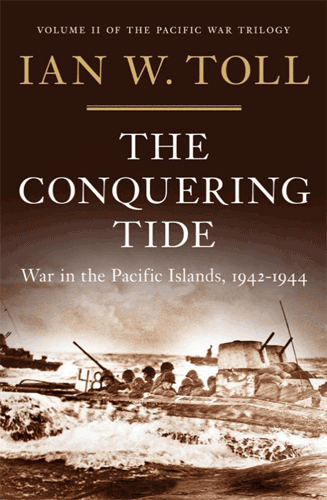
The Conquering Tide: War in the Pacific Islands, 1942-1944
Ian W. Toll
This second volume of Ian W. Toll’s Pacific war trilogy encompasses the heart of the Pacific War―the period between mid-1942 and mid-1944―when parallel Allied counteroffensives north and south of the equator washed over Japan's far-flung island empire like a "conquering tide," concluding with Japan's irreversible strategic defeat in the Marianas. It was the largest, bloodiest, most costly, most technically innovative and logistically complicated amphibious war in history, and it fostered bitter interservice rivalries, leaving wounds that even victory could not heal.
Often overlooked, these are the years and fights that decided the Pacific War. Ian W. Toll's battle scenes―in the air, at sea, and in the jungles―are simply riveting. He also takes the reader into the wartime councils in Washington and Tokyo where politics and strategy often collided, and into the struggle to mobilize wartime production, which was the secret of Allied victory. Brilliantly researched, the narrative is propelled and colored by firsthand accounts―letters, diaries, debriefings, and memoirs―that are the raw material of the telling details, shrewd judgment, and penetrating insight of this magisterial history.
This volume―continuing the "marvelously readable dramatic narrative" (San Francisco Chronicle) of Pacific Crucible―marks the second installment of the Pacific War Trilogy, which will stand as the first history of the entire Pacific War to be published in at least twenty-five years. Complete with 32 pages of helpful illustrations.
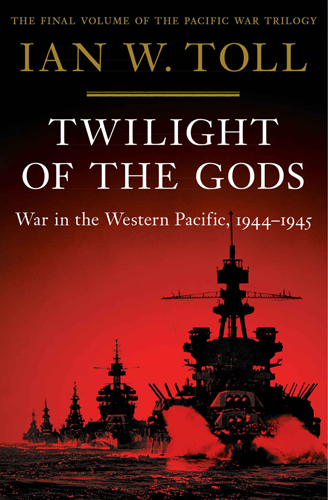
Twilight of the Gods: War in the Western Pacific, 1944-1945
Ian W. Toll
The final volume of the magisterial Pacific War Trilogy from acclaimed historian Ian W. Toll, “one of the great storytellers of War” (Evan Thomas).
In June 1944, the United States launched a crushing assault on the Japanese navy in the Battle of the Philippine Sea. The capture of the Mariana Islands and the accompanying ruin of Japanese carrier airpower marked a pivotal moment in the Pacific War. No tactical masterstroke or blunder could reverse the increasingly lopsided balance of power between the two combatants. The War in the Pacific had entered its endgame.
Beginning with the Honolulu Conference, when President Franklin Delano Roosevelt met with his Pacific theater commanders to plan the last phase of the campaign against Japan, Twilight of the Gods brings to life the harrowing last year of World War II in the Pacific, when the U.S. Navy won the largest naval battle in history; Douglas MacArthur made good his pledge to return to the Philippines; waves of kamikazes attacked the Allied fleets; the Japanese fought to the last man on one island after another; B-29 bombers burned down Japanese cities; and Hiroshima and Nagasaki were vaporized in atomic blasts.
Ian W. Toll’s narratives of combat in the air, at sea, and on the beaches are as gripping as ever, but he also reconstructs the Japanese and American home fronts and takes the reader into the halls of power in Washington and Tokyo, where the great questions of strategy and diplomacy were decided.
Drawing from a wealth of rich archival sources and new material, Twilight of the Gods casts a penetrating light on the battles, grand strategic decisions and naval logistics that enabled the Allied victory in the Pacific. An authoritative and riveting account of the final phase of the War in the Pacific, Twilight of the Gods brings Toll’s masterful trilogy to a thrilling conclusion. This prize-winning and best-selling trilogy will stand as the first complete history of the Pacific War in more than twenty-five years, and the first multivolume history of the Pacific naval war since Samuel Eliot Morison’s series was published in the 1950s.
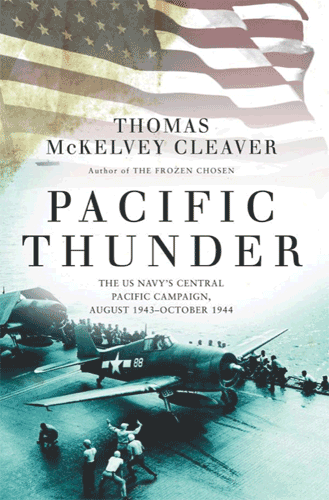
Pacific Thunder: The US Navy's Central Pacific Campaign, August 1943–October 1944
Thomas McKelvey Cleaver
On 27 October 1942, four “Long Lance” torpedoes fired by the Japanese destroyers Makigumo and Akigumo exploded in the hull of the aircraft carrier USS Hornet (CV-8). Minutes later, the ship that had launched the Doolittle Raid six months earlier slipped beneath the waves of the Coral Sea 100 miles northeast of the island of Guadalcanal and just north of the Santa Cruz Islands, taking with her 140 of her sailors. With the loss of Hornet, the United States Navy now had one aircraft carrier left in the South Pacific, USS Enterprise (CV-6), herself badly damaged in the two previous days of the Battle of Santa Cruz, the fourth Japanese–American carrier battle since the Battle of the Coral Sea five months and three weeks before. Of the prewar carrier fleet the Navy had struggled to build over 15 years, only three were left: Enterprise licked her wounds at Espiritu Santo while USS Saratoga (CV-3) lay in dry dock at the Bremerton Navy Yard, victim of a Japanese submarine torpedo two months earlier. USS Ranger (CV-4) was in mid-Atlantic on her way to support Operation Torch, the invasion of North Africa.
Ten months after the loss of Hornet at Santa Cruz, an entirely new fleet of aircraft carriers would begin to make their presence known in the Pacific, starting with a raid by USS Essex (CV-9), class leader of the largest and most important class of capital ships ever built, and USS Lexington (CV-16), namesake of the carrier sunk at Coral Sea, against the Japanese-held island of Marcus. Fourteen months later, the islands of the south and central Pacific would be under American domination, led by the ships of the Fast Carrier Task Force, which would cement their position as the strongest naval fighting force ever to set sail, in the largest naval battle of history.
The fourteen months of the Central Pacific Campaign constitute the most successful naval campaign ever undertaken and Pacific Thunder will put all elements of this campaign into historical context.
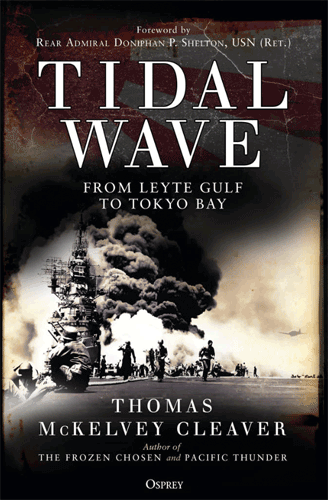
Tidal Wave: From Leyte Gulf to Tokyo Bay
Thomas McKelvey Cleaver
The United States Navy won such overwhelming victories in 1944 that, had the navy faced a different enemy, the war would have been over at the conclusion of the Battle of Leyte Gulf.
However, in the moment of victory on 25 October 1944, the US Navy found itself confronting an enemy that had been inconceivable until it appeared. The kamikaze, 'divine wind' in Japanese, was something Americans were totally unprepared for; a violation of every belief held in the West. The attacks were terrifying: regardless of the damage inflicted on an attacking airplane, there was no certainty of safety aboard the ship until that airplane was completely destroyed.
Based on first-person accounts, Tidal Wave is the story of the naval campaigns in the Pacific from the victory at Leyte Gulf to the end of the war, in which the US Navy would fight harder for survival than ever before.
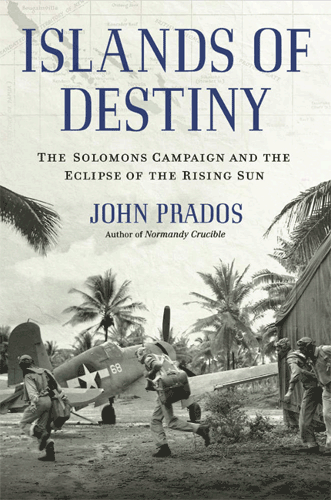
Islands of Destiny: The Solomons Campaign and the Eclipse of the Rising Sun
John Prados
The Solomons arena saw some of the most intense combat of WWII—from major naval actions, including a key confrontation between battleships, to air battles that took place almost daily. With expert knowledge and crystal clear prose, John Prados illustrates why these events were not only thrilling, but pivotal in the Allies’ path to victory.
Historians traditionally refer to the Battle of Midway as the point when Allied forces gained the advantage over the Japanese. In Islands of Destiny, Prados points out that the Japanese forces quickly regained strength after Midway and continued their assault undaunted. Taking this surprising fact as the start of his inquiry, he began to investigate how and when the Pacific tide turned in the Allies’ favor. His search led him to the decisive battles and strategic maneuvers in the fight for the Solomon Islands.
Beginning with the invasion of Guadalcanal in August 1942, the Solomons became a hotly contested battleground for over a year, culminating in the isolation of Rabaul by the Allies. As military forces fought over the strategically important islands, a secret war of intelligence was also being waged. For a total picture of the conflict, Prados integrates blow-by-blow action on the ground with the code breaking, aerial reconnaissance, secret spy posts, and submarine scouting that were vital to the Allied effort.
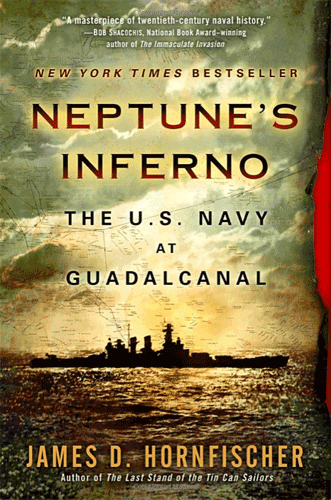
Neptune's Inferno: The U.S. Navy at Guadalcanal
James D. Hornfischer
The Battle of Guadalcanal has long been heralded as a Marine victory. Now, with his powerful portrait of the Navy's sacrifice, James D. Hornfischer tells for the first time the full story of the men who fought in destroyers, cruisers, and battleships in the narrow, deadly waters of "Ironbottom Sound." Here, in stunning cinematic detail, are the seven major naval actions that began in August 1942, a time when the war seemed unwinnable and America fought on a shoestring, with the outcome always in doubt. Working from new interviews with survivors, unpublished eyewitness accounts, and newly available documents, Hornfischer paints a vivid picture of the officers and enlisted men who opposed the Japanese in America's hour of need. The first major work on this subject in almost two decades, Neptune's Inferno does what all great battle narratives do: It tells the gripping human stories behind the momentous events and critical decisions that altered the course of history and shaped so many lives.
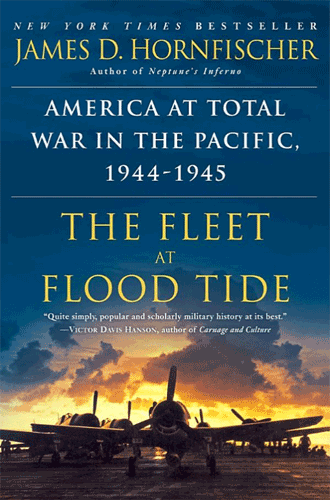
The Fleet At Flood Tide: America At Total War In The Pacific 1944-1945
James D. Hornfischer
With its thunderous assault on the Mariana Islands in June 1944, the United States crossed the threshold of total war. In this tour de force of dramatic storytelling, distilled from extensive research in new primary sources, James D. Hornfischer brings to life the campaign that was the fulcrum of the drive to compel Tokyo to surrender--and forever changed the art of modern war. With a close focus on high commanders, front-line combatants, and ordinary people, American and Japanese alike, Hornfischer tells the story of the climactic end stage of the Pacific War as has never been done before. Here are the epic seaborne invasions of Saipan, Tinian and Guam; the stunning aerial battles of the Great Marianas Turkey Shoot; the first large-scale use of Navy underwater demolition teams; the largest banzai attack of the war; and daring combat operations large and small that made possible the strategic bombing offensive culminating in the atomic strikes on Hiroshima and Nagasaki.
From the seas of the Central Pacific to the shores of Japan itself, The Fleet at Flood Tide is a stirring, authoritative, and cinematic portrayal of World War II's world-changing finale.
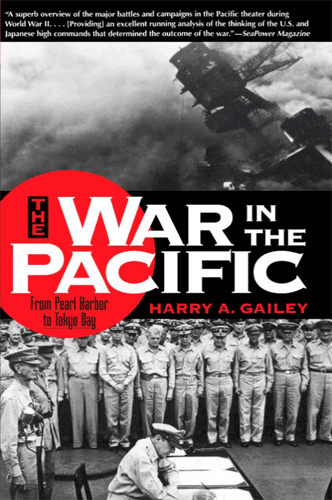
War in the Pacific: From Pearl Harbor to Tokyo Bay
Harry A. Gailey
Historian Harry Gailey offers a fresh one-volume treatment of the vast Pacific theater in World War II, examining in detail the performance of Japanese and Allied naval, air, and land forces in every major military operation. The War in the Pacific begins with an examination of events leading up to World War II and compares the Japanese and American economies and societies, as well as the chief combatants' military doctrine, training, war plans, and equipment. The book then chronicles all significant actions - from the early Allied defeats in the Philippines, the East Indies, and New Guinea; through the gradual improvement of the Allied position in the Central and Southwest Pacific regions; to the final agonies of the Japanese people, whose leaders refused to admit defeat until the very end. Gailey gives detailed treatment to much that has been neglected or given only cursory mention in previous surveys. The reader thus gains an unparalleled overview of operations, as well as many fresh insights into the behind-the-scenes bickering between the Allies and the interservice squabbles that dogged MacArthur and Nimitz throughout the war.
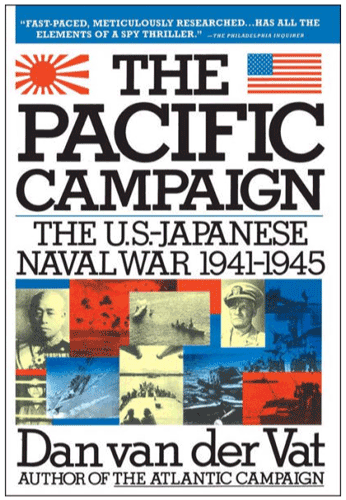
Pacific Campaign: The U.S.-Japanese Naval War 1941-1945
Dan van der Vat
Dan van der Vat's naval histories have been acclaimed on both sides of the Atlantic as “definitive,” “extraordinary,” and “vivid and harrowing.”
Now he turns to the greatest naval conflict in history: the Pacific campaign of World War II. Drawing on neglected archives of firsthand accounts from both sides, van der Vat interweaves eyewitness testimony with sharp, analytical narration to provide a penetrating reappraisal of the strategic and political background of both the Japanese and American forces, as well as a major reassessment of the role of intelligence on both sides. A comprehensive evaluation of all aspects of the war in the Pacific, The Pacific Campaign promises to be the standard work on the U.S.-Japanese war for years to come.
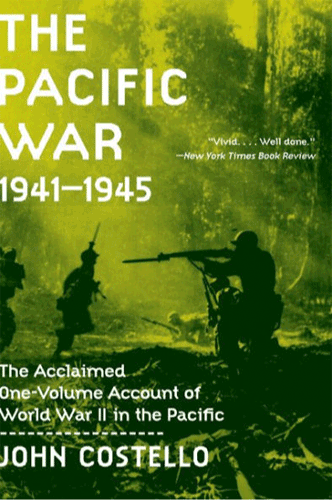
The Pacific War 1941-1945
John Costello
A definitive one-volume history of World War II in the Pacific theater, The Pacific War was the first book to weave together the separate stories of the fighting in China, Malaya, Burma, the East Indies, the Philippines, New Guinea, the Solomon Islands, and the Aleutians. Now available with a new cover, John Costello’s classic work provides a brilliantly clear account of one of the most massive movements of men and arms in military history.
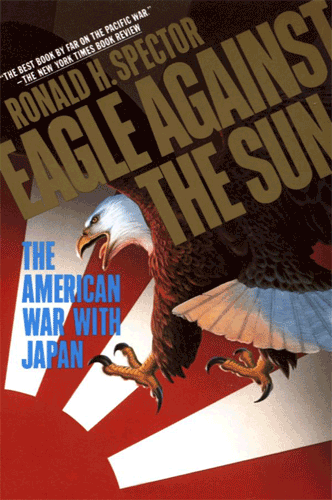
Eagle Against the Sun: The American War With Japan
Ronald Spector
A stunning history of the war in the Pacific written by award-winning military historian Ronald Spector. Drawing on declassified intelligence files, an abundance of British and American archival material, Japanese scholarship and documents, and research and memoirs of scholarly and military men, Spector focuses on the major battles in the Pacific theater as well as the smaller details, from the various rivalries between branches of the U.S. armed services to the problems of command and allocating resources. Spector has written "the best one-volume history of that complex conflict" (The New York Times). Only now [1985] can the full scope of the war in the Pacific be fully understood.
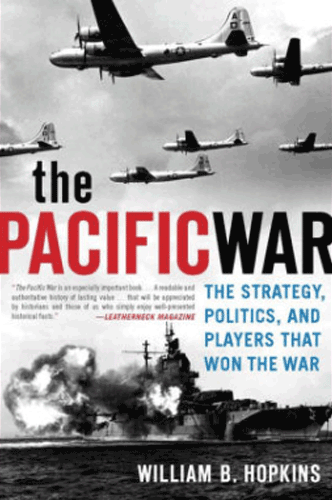
The Pacific War: The Strategy, Politics, And Players That Won The War
William B. Hopkins
The Pacific War is a superb book that covers a huge subject about as well as can be done in one volume. Written recently enough that Mr. Hopkins had access to declassified material, this book provides a fresh take on World War II in the Pacific that goes beyond the simple recounting of battles won and lost to synthesize the strategies, politics, and key players that shaped the conduct of the war. The author takes a regional approach to this multifaceted, often nonlinear, war conducted on land, sea (and, significantly by America, undersea), and in the air across the immense reaches of the Pacific to effectively develop the major themes and causes of the battles.
One now sees the great figures of that era in a new light. Hopkins makes a welcomed effort to correct the nearly universally held view of McArthur’s performance during the war. That effort is a rare stab at the slavish deification created by his worshipers and also shows General MacArthur’s fixation on the Philippines and his derogatory attitude of the US Navy and its central Pacific drive.
The author stresses throughout the book that this war was a NAVAL war that included the crucial land battles. In many important ways it WAS a naval war between the US Navy and the Japanese Navy. This book also makes known the FACT that the US Navy's submarine fleet accounted for fully 55% of all Japanese ships sunk or destroyed during WWII. Admiral Chester Nimitz, Commander-in-Chief, U.S. Pacific Fleet, is given the credit that he is due. Also of great interest was the description of the vast U.S. naval supply and repair facility at Ulithi in the Caroline’s, in late-1944 to early-1945, which unquestionably was a key element in victory and which was kept secret at the time. This is a very informative and readable history of the Pacific war.
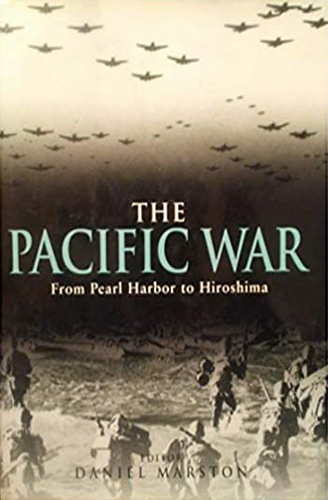
The Pacific War: From Pearl Harbor to Hiroshima
Daniel Marston (Editor)
Twelve world-renowned military historians provide a fresh reevaluation of the events, troops, strategies, and tactics of the Pacific campaign of World War II.
Despite unforgiving conditions and brutal jungle fighting that drained resources and morale, the American advance across the ocean towards the Japanese homeland drove the evolution of ever more innovative amphibious warfare and increasingly desperate Japanese countermeasures.
Bringing together American, Japanese, Australian, and British perspectives, each chapter of The Pacific War: From Pearl Harbor to Hiroshima focuses on a different aspect of the conflict -- from operational planning to the experiences of the men on the ground, and from the assault on Pearl Harbor to the atomic annihilation of Nagasaki and Hiroshima.
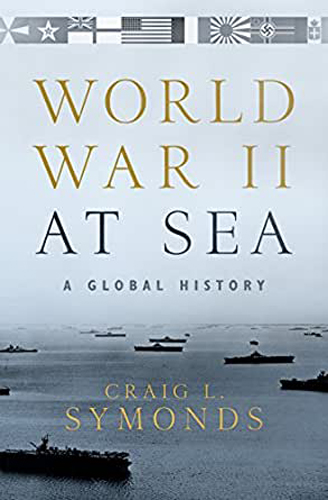
World War II at Sea: A Global History
Craig L. Symonds
Author of Lincoln and His Admirals (winner of the Lincoln Prize), The Battle of Midway (Best Book of the Year, Military History Quarterly), and Operation Neptune, (winner of the Samuel Eliot Morison Award for Naval Literature), Craig L. Symonds has established himself as one of the finest naval historians at work today. World War II at Sea represents his crowning achievement: a complete narrative of the naval war and all of its belligerents, on all of the world's oceans and seas, between 1939 and 1945.
Many have argued that World War II was dominated by naval operations; few have shown and how and why this was the case. Symonds combines precision with story-telling verve, expertly illuminating not only the mechanics of large-scale warfare on (and below) the sea but offering wisdom into the nature of the war itself.

